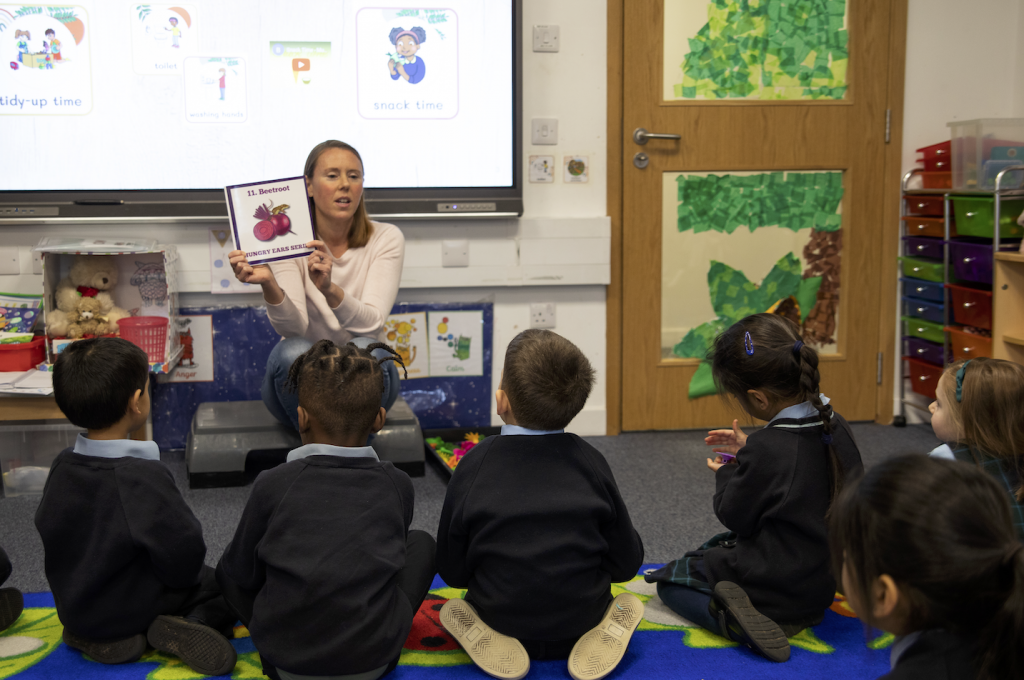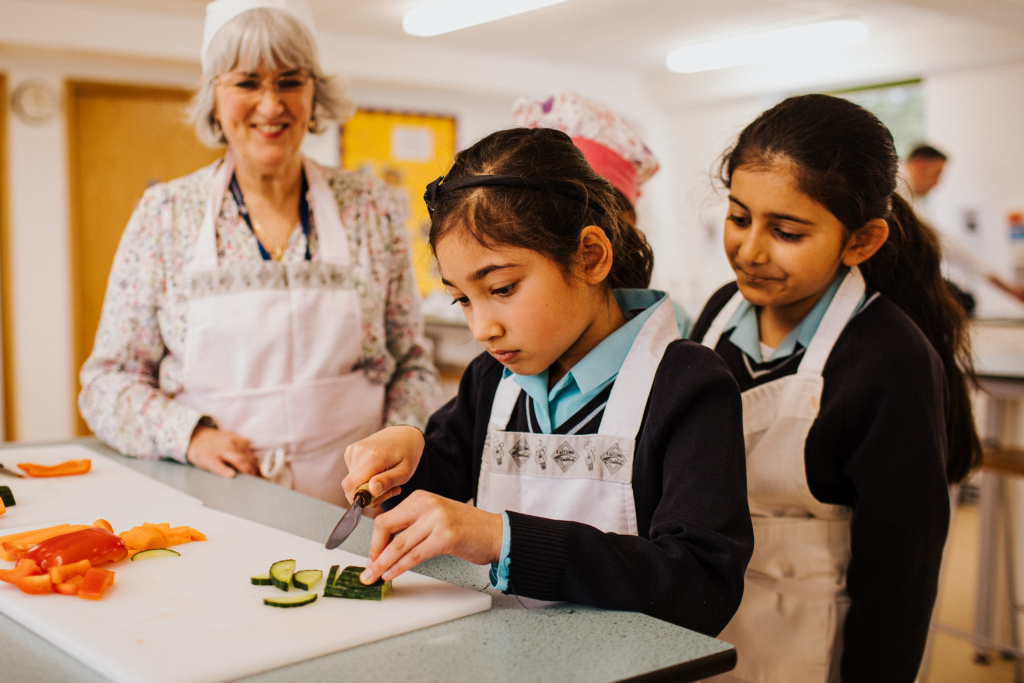
As reported by NHS Digital in 2018, just 18% of children aged between five and 15 years ate the recommended five or more portions of fruit and vegetables per day. The results were similar for both girls and boys. Yet fruit and vegetables provide the cornerstone of a healthy diet, containing essential vitamins and minerals that support a child’s rapidly growing body and developing brain. Without adequate levels of vitamins and minerals, children are at risk of poor brain development, delayed learning and low immunity. They are also at increased risk of infection. This can result in absence from school and poor outcomes for health and education in the long term.
I am passionate about reinforcing the importance of a healthy diet and helping children to learn in a way that is digestible and inspiring. During 2023 at St Margaret’s, we launched weekly nutrition workshops for our youngest pupils in Reception and Year 1 to capitalise on the early ‘window of opportunity’ and to help pupils establish lifelong healthy eating habits. This programme has had great success to date.
Key messages
Introducing young children to the benefits of healthy eating has to be delivered in a way that is interactive, memorable, fun and enriching in terms of the overall experience. The children attending these workshops are aged four to six years, so it is important that sessions are short and engaging but emphasise key messages around food in a way that they understand.
As a school, we have qualified nutritionist Caroline Mentzer delivering these carefully tailored sessions to our pupils. She has found that younger children are really interested in what they eat but believes that simply telling them to eat five a day, or that fruit is good for them, does little for their motivation and general interest.
Ms Mentzer, who has worked in the field of children’s health for over two decades, explained: ‘I’ve found that the children at St Margaret’s are really interested in learning how certain foods can benefit them and most of them can tell you that carrots help you to see in the dark. Ensuring that the sessions are regular has helped to ensure that they are slowly but surely making the connection between eating real food and experiencing good health.’
Over the last few months, the children have been exposed to a number of fun activities which are helping them to identify a wide range of seasonal fruits, vegetables and herbs, as well as learning why they should include them in their diet. The weekly workshops use a combination of storytelling, colour coding and craft activities to emphasise key messages around healthy food. The stories usually follow an interactive discussion with the children about a particular food, and then they participate in a craft activity related to it.
Relatable stories
The format for each workshop is 25 minutes maximum; long enough to retain attention. We find it important that the workshops are relatable and enjoyable and end with a key takeaway message. For example, the sessions usually begin with a story about a tiny harvest mouse who has found herself living in a human house. This is a character that the children have come to know and love. The mouse spends her time nibbling leftovers and gains a superpower from every piece of fruit or vegetable she eats. Each week, the children discuss that superpower and finish the session with an activity that focuses on that particular food.

For instance, in a past session the children learned about the benefits of beetroot. When the harvest mouse nibbled some, she gained super strength and managed to escape the clutches of the family pet cat. The message here would be that red beetroot contains the mineral iron, which is needed for muscle strength and energy. The result being: beetroot can help make you strong. At the end of each session, the children participate in a craft activity that emphasises the food they have learned about. In this case, they made red playdough out of beetroot juice and then modelled their very own beetroot.
A future session also involved a night-time adventure where the harvest mouse visited some allotments and nibbled some carrots to reveal amazing night vision. The children enjoyed discussing the benefits of growing your own vegetables and even designed their very own vegetable patch as part of the workshop. Linking the sessions to topical themes or seasons has worked really well too as it helps children to visualise what they learn.
Last year, the children enjoyed a session around bonfire night and Diwali about the healing benefits of ginger. They learned how it was traditionally used to settle the stomach. The story that week looked at how pets and wild animals might feel frightened by the persistent loud bangs emitted from fireworks and how our bodies can physically show signs of worry or stress – for instance, butterflies in our tummies. The children talked with our nutritionist about how spicy ginger can feel like a taste explosion on the tongue and at the end of the session they created some beautiful firework collages to visualise this.
Sparking interest
The impact of regular nutrition workshops for our youngest pupils has been very encouraging to date. The children are really enjoying the sessions with Caroline, they can easily recount what they’ve learned and they get lots of hands-on experience with healthy foods too. There is also the communication aspect of the sessions, encouraging pupil voice and feedback as well as creativity from a young age. It is wonderful to hear the pride in their voices when they share their knowledge with others around them.
While children are young, it’s so important for schools to exploit this crucial window of opportunity to reinforce the importance of a healthy diet and help them learn about food and cooking in a way that sparks their interest. The more they understand about the food they eat, the stronger the foundation for their educational outcomes and their future lives.
Children often fear the unknown and will reject a food simply because it looks unfamiliar. Getting up close and personal with all kinds of fruit, vegetables and herbs means they get used to seeing and exploring a variety of foods, which will help them to make healthy and more varied choices as they grow up. Young children are naturally inquisitive, so the underlying aim of introducing these workshops was to provide a strong foundation for future learning about what constitutes a healthy and balanced diet. I believe we have succeeded.
Emma Gray is Head of St Margaret’s Junior School in Hertfordshire, prior to which she was Head of Pre-Prep at York House School. She has held a number of senior teaching posts and completed her teacher training with a Master’s Degree in Teaching from The University of Notre Dame while living in Western Australia.
St Margaret’s School is an independent day and boarding school for pupils aged two to 18 years. Based in Bushey, Hertfordshire, the school is steeped in history dating back to 1749. Offering a range of flexible boarding options for both UK and international pupils from the age of 11 years, the school is set over 60 acres of beautiful grounds and places its renowned pastoral care and proven track record of academic success at the heart of its culture and ethos. With a rich programme of extra-curricular activities, its pupils are encouraged to discover their talents in a caring environment that fosters a genuine enthusiasm for learning in an evolving world filled with complex challenges and exciting new possibilities.
Register for free
No Credit Card required
- Register for free
- Free TeachingTimes Report every month